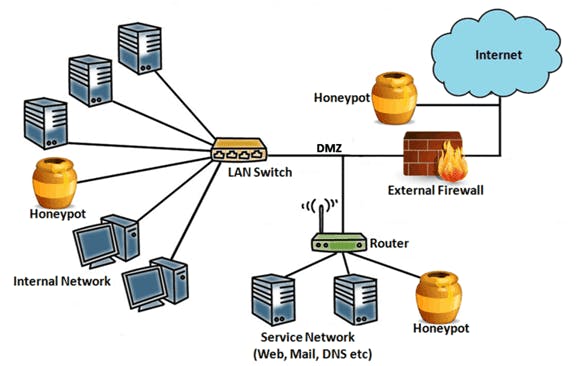In today's world, breaches in a network are inevitable. The number of cyber crimes is constantly increasing and hackers are able to topple the regular methods of network defense. What if I told you that you could bait and trap attackers within your network? This is where the delightful but deceptive honeypot comes in!
Honeypot was a term used in the espionage world, where an alluring agent was used to deceive and trap a target for valuable intelligence. In the world of cybersecurity, honeypots are used as a decoy to distract cyber attackers from their real targets. They mimic likely targets of cyberattacks, such as vulnerable networks but don't contain any actual information. When hackers are lured in by these honeypots, security analysts are then able to gather information about their identities and methods of attack. A Honeynet refers to the combination of two or more honeypots on a network.
Installing a honeypot at the right point in the network is very crucial. In a network, an external honeypot, placed before the firewall can decrease the risk of internal attacks and reduce traffic to the firewall. Placing it in the demilitarized zone (DMZ), the area that is out of your main network, but still behind a router, prevents attacks but this area is not fully accessible. Installing it in the internal network along with servers and workstations can help in catching internal attacks and detecting a misconfigured firewall.

Honeypots can be of four types:
Email traps: These are used to attract spam traffic and block those particular IP addresses to prevent phishing.
Malware honeypots: These mimic software apps and APIs to invite malware attacks. Weaknesses found are used to create anti-malware solutions.
Spider honeypots: These trap web crawlers and help in blocking malicious bots, as well as ad-network crawlers.
Database honeypots: Decoy databases are used to attract and distract the hackers that get through firewalls.
Using honeypots can benefit you in multiple ways. They help to expose vulnerabilities in a major system, are resource-light, have a low false positive rate in comparison to IDS and also give you reliable intelligence about how threats are evolving. However, it is important to have other kinds of security mechanisms as well and not just rely on honeypots because once a honeypot has been fingerprinted, an attacker can create spoofed attacks to distract attention from a real exploit being targeted against your production systems. They can also introduce risk to your environment. A honeypot, once attacked, can be used to attack and infiltrate your systems.
In conclusion, cyber deception techniques like installing honeypot traps are effective in detecting and thwarting malicious work from cyber criminals and can be a great supplement to even a well-secured network.
